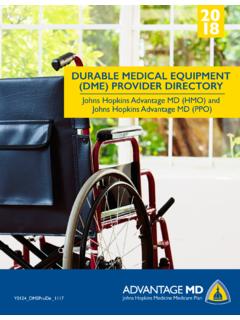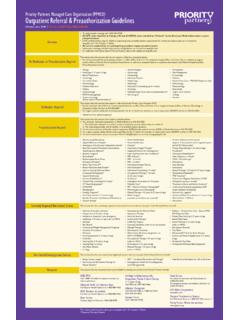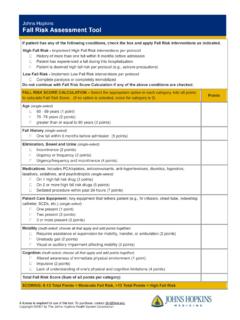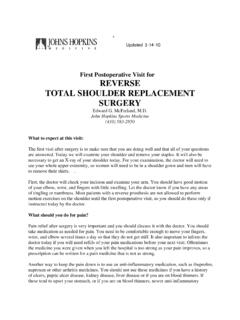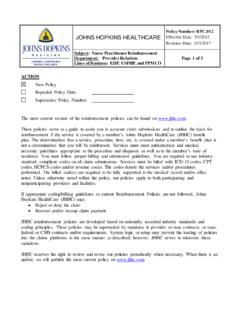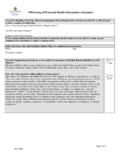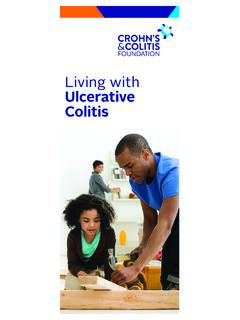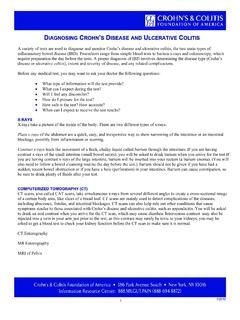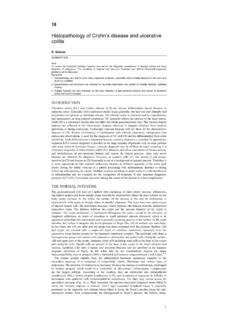Transcription of Crohn's Disease: Introduction - Hopkins Medicine
1 Figure 1. Location of the colon in the 's disease : Introduction Inflammatory bowel disease encompasses two idiopathic, chronic, inflammatory diseases: Crohn s disease and ulcerativecolitis. Crohn s disease and ulcerative colitis are disorders of unknown cause, involving genetic and immunological influenceon the gastrointestinal tract s ability to distinguish foreign from self-antigens. They share many overlapping epidemiological,clinical, and therapeutic characteristics. In some patients it is not possible to distinguish which form of inflammatory boweldisease is present (Figure 2). Figure 2. Inflammatory bowel disease are, however, important pathological and clinical differences that distinguish these inflammatory disease processes.
2 Clinically, Crohn's disease tends to presentmore frequently with abdominal pain and perianal disease , whereas ulcerative colitis is more often characterized by gastrointestinal bleeding. Cobblestoning mucosaand aphthous or linear ulcers characterize the endoscopic appearance of Crohn s disease . ulcerative colitis presents with diffuse continuous involvement of themucosa. Radiographic studies of patients with Crohn s disease characteristically show fistulae, asymmetry, and ileal involvement. In contrast, radiographic studies ofpatients with ulcerative colitis show continuous disease without fistulizing or ileal disease . Pathologically, Crohn's disease features mucosal discontinuity, transmuralinvolvement, and granulomas, whereas ulcerative colitis does not.
3 Crypt abscesses and granulomas are present only in Crohn's disease . Figure 3 compares theanatomic distribution of Crohn s disease and ulcerative colitis . Figure 3. Anatomic distribution of Crohn s disease and ulcerative 's disease is a form of inflammatory bowel disease . The term Crohn's disease has replaced older terms, which included regional enteritis, regional or terminalileitis, and granulomatous colitis . Although the terminal ileum and the right colon are the most commonly involved sites, a similar pathological and clinical disorder canaffect any part of the gastrointestinal tract, from the mouth to the perianal area. Only one third of patients with Crohn s disease have granulomatous inflammation.
4 Thebroad term Crohn s disease does not imply any one cause, site, or pathological response. Crohn s is a chronic illness that requires expensive medications, oftenhospitalization and/or surgery, and results in a heavy social and economic toll. Figure 4. Comparison of the appearance of normal, Crohn s, and ulcerative colitis mucosa; gross (top);histological (center); endoscopic (bottom).The geographic distribution of Crohn's disease historically suggested a north-south gradient of incidence; however, more recent investigations have reportedincreased prevalence in temperate regions of North America, South Africa, and Australia. Urban areas have a higher incidence of disease than rural populations, andethnic minorities (south Asians in the United Kingdom, blacks in South Africa, Bedouin Arabs in Israel) are at lower risk.
5 Jews originating from middle Europe(Ashkenazi Jews) and those individuals of Scandinavian descent are at increased risk (Figure 5). Figure 5. Geographic distribution of Crohn s disease . What is Crohn's disease ?Crohn s disease is a chronic inflammatory disease of the gastrointestinal tract. Inflammation extends all the way through the intestinal wall from mucosa to ulcerative colitis , Crohn s disease is a relapsing and remitting disease . Initially only a small segment of the gastrointestinal tract may be involved, but Crohn sdisease has the potential to progress surgical resection of inflamed segments may temporarily arrest symptoms, subsequent inflammation is likely to recur. Resection is not curative in Crohn sdisease, which is in contrast to ulcerative colitis , where colectomy eliminates the illness usually appears early in life; about one-sixth of patients present before the age of 15 and often with severe disease .
6 The average age at diagnosis is 27years. The cause of Crohn s disease is unknown, although strong genetic influences are suggested by the occurrence of this disease in families, with a higherincidence in Jews than in the general population. Genetic influences are more prominent in the younger onset subgroup of patients than those who present after theage of one-third of patients with Crohn s disease , the gross pathologic changes are limited to the terminal part of the ileum. About 40% of patients have ileocolitis,involvement of the distal ileum and proximal colon. About 5% have ileojejunitis, in which there is either continuous involvement throughout the small bowel, or morecommonly, several sharply demarcated skip areas separated by normal bowel, sparing the terminal ileum.
7 As many as one-third of young patients with Crohn'sdisease have subtle microscopic and macroscopic ulceration of the gastric antrum and the duodenum. In these cases, the lesions are not often symptomatic. Up to20% of patients have involvement limited to the colon (Figure 6).Figure 6. Anatomic distribution of Crohn s colonic lesions are often segmental and sometimes spare the rectum; this helps to distinguish them from ulcerative colitis , which always involves the rectum andis continuous rather than segmental. Crohn's disease is also more likely than ulcerative colitis to cause fistula, benign fibrous strictures, and perianal disease . Despitethese differences, in about 10% of patients with chronic inflammatory bowel disease confined to the colon both macroscopically and microscopically, the diagnosismust be classified as indeterminate.
8 This distinction becomes important when the clinician is considering surgery. ulcerative colitis can be cured by total colectomy,and disease does not recur in an ileoanal pouch. However, patients with Crohn's disease can have troublesome recurrences in the ileum. Alternatively, segmentalresections of the colon can be helpful in patients with Crohn s patients with Crohn's disease have focal mucosal inflammation seen endoscopically and aphthous ulcers visible macroscopically scattered throughout extensiveportions of an otherwise normal bowel. The widespread microscopic disease may partially account for the high rate of recurrence (50% at 5 I0 years) after surgicalresection of all gross disease . With time, the inflammation extends through most layers of the bowel.
9 In contrast, ulcerative colitis usually remains within the mucosa;in only a few patients does colitis go on to perforate. Noncaseating granulomas are found in 30 50% of resected bowel sections from patients with Crohn's are usually considered diagnostic, since granulomas are rare in ulcerative colitis . The pathologic findings in Crohn's disease correlate with three distinct disease courses. The inflammatory type affects 30% of patients, remains localized to themucosa and submucosa, and causes diarrhea and pain from acute partial obstruction. Fistulizing or perforating disease affects 20% of patients who have transmural inflammation leads to intra-abdominal fistulae from the diseased bowel wall to another bowel loop, or to a nearby organ like the urinarybladder.
10 Some patients suffer free bowel perforation early in the disease . Figure 7. Types of Crohn s disease ; A, stenosing; B, inflammatory; C, fistulizing; D, radiographic imageof or stricturing disease characterizes the third course. About 50% of patients with ileitis follow this route. Early in the course of Crohn's disease in the smallbowel, patients seem to develop muscle hypertrophy followed by collagen (scar) deposition. After about 7 8 years of ileal disease , patients develop a fixed, scarredobstruction that causes painful cramping and requires surgical management. Most patients go to surgery 8 10 years after the onset of disease or after a previousresection for obstruction. This obstructive process seems to be caused by inflammatory cytokines that are not inhibited by corticosteroids, anti-inflammatorysalicylates, or immunomodulator drugs.
